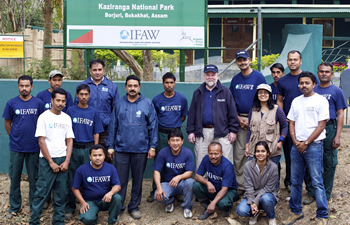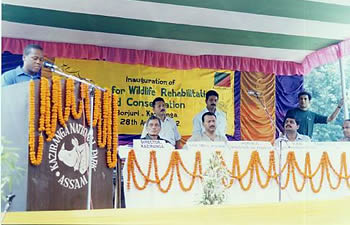27
Aug
CWRC turns 10 : 1600 animals including rare tigers , rhinos , elephants rescued
0 Comment
The CWRC team today with senior officials from IFAW and WTI
Guwahati, Assam, August 27, 2012: Elephant calf injured in conflict with people, a rhino orphaned by poachers, a full-grown tiger in a well or a leopard in a house! These are four of 1600 animals and 166 species saved by the Centre of Wildlife Rehabilitation and Conservation (CWRC) that celebrates its 10th anniversary tomorrow.
Situated near Kaziranga National Park – a UNESCO World Heritage Site (WHS) in the northeast Indian state of Assam, CWRC was launched this day in 2002 by the Assam Forest Department and the International Fund for Animal Welfare – Wildlife Trust of India (IFAW-WTI).
The CWRC inaugaration in 2002
Since then it has also pioneered hand-raising and rehabilitation of numerous species of wild animals in India including that of the clouded leopards, rhinos, elephants, bears and even birds like the greater adjutant storks and India’s only apes -the Hoolock gibbons.
“CWRC addresses cases of wild animals in distress, be it due to natural causes such as floods, or even man-made causes including conflicts. Assam has set numerous exemplary wildlife conservation and welfare milestones for the entire country to follow, and this centre is one of those – our pride,” said Suresh Chand, Principal Chief Conservator of Forest (Wildlife) and Chief Wildlife Warden, Assam Forest Department.
The first MVS commisioned
Floods in the River Brahmaputra cause massive displacement of animals from Kaziranga, as was witnessed this year. CWRC was conceptualised and strategically placed targeting this issue.
“While CWRC has handled a wide variety of cases, in terms of numbers, it is the floods that have brought most animals under its care. For example during this year’s flood season in Kaziranga lasting about a month, CWRC saved nearly 100 animals,” said Sanjib Kumar Bora, Field Director, Kaziranga NP and Project Leader, CWRC.
Till date, CWRC along with its satellite Mobile Veterinary Service (MVS) units has attended to nearly 3000 cases of animals in distress across northeast India. Dead on arrival and those beyond help also make up a significant chunk of these.
“The IFAW Wildlife Rescue Centre has achieved pioneering work in the rehabilitation of endangered wildlife, including a number of notable firsts – the first orphan Asian elephants returned to the wild and the first documented release of hand-reared clouded leopards,” said Ian Robinson, IFAW Animal Rescue Director. “The center staff has much to be proud of.”
Combining animal welfare ethics to wildlife conservation, CWRC has worked for more than just saving individual animals in distress. Among the most significant achievements of CWRC include reintroduction of rhinos to Manas National Park – another UNESCO WHS in Assam that had lost its entire rhino population to poachers. Orphaned rhino calves hand-raised at CWRC were moved to the wild in Manas, kick-starting the crucial rhino reintroduction programme in 2006.
Likewise, displaced elephant calves, orphaned clouded leopards, Asiatic black bear cubs have been hand-raised and released in Manas landscape.
“Commitment is what makes CWRC different. Only within a decade, it has grown to what it is now, despite its share of difficulties or even life-threatening situations faced by people on field,” says Vivek Menon, Executive Director, WTI.
The situations Menon speaks of are accidents involving the rescue team members – tiger attack on a forest guard, gunshot sustained by an IFAW-WTI vet, snakebite by an animal keeper, leopard attack on another, among others. “Many have contributed to the establishment of CWRC, including BS Bonal (the current CZA director) and Maneka Gandhi, without whose help this centre would not have existed. Still, if CWRC today is among the top rehabilitation centres, then it is primarily to these professionals on ground – their experience, their skills, their commitment, that we credit the achievement.”
“The benefit of a centre like CWRC extends beyond the obvious,” adds Menon. “There is little doubt that seeing people put their own lives at risk to save animals would not inspire others. We now see more and more local people coming forward to save wildlife and over long-term that is what matters.”
CWRC has also provided opportunities to aspiring wildlife veterinarians from India and abroad to hone their skills in wild animal welfare and treatment. A number of veterinarians have been trained at CWRC, working as volunteers, interns or even as staff members.
Photos: WTI archives












